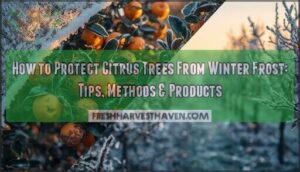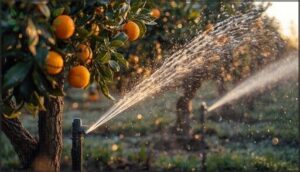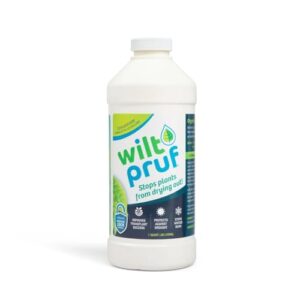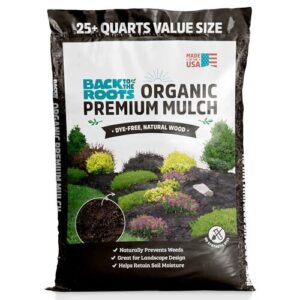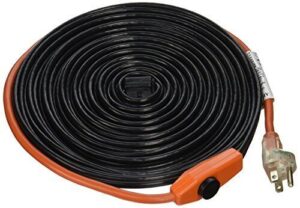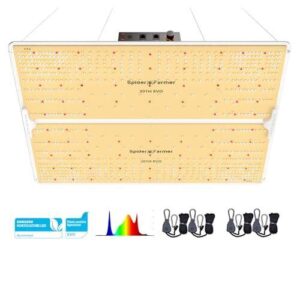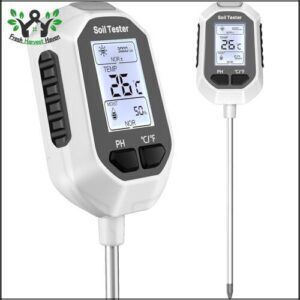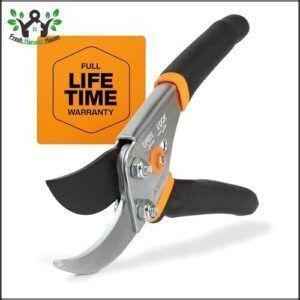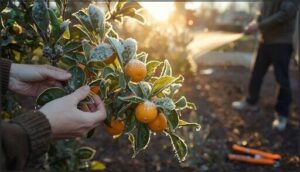This site is supported by our readers. We may earn a commission, at no cost to you, if you purchase through links.
A single night below 28°F can destroy months of growth on your citrus trees. The fruit splits. The leaves turn brown and drop. Young branches die back to the trunk. Most citrus growers learn this lesson the hard way when an unexpected cold snap hits in December or January.
The damage happens fast because citrus trees evolved in subtropical climates where freezing temperatures rarely occur. Your trees lack the natural defenses that temperate fruit trees develop through dormancy.
But you can prevent this destruction with the right preparation and protection methods. Understanding when temperatures become dangerous and how to shield your trees makes the difference between a healthy harvest and a year of recovery.
Table Of Contents
Key Takeaways
- Citrus trees need protection when temperatures drop to 32°F or below, with lemons damaged near 30°F and oranges tolerating 28°F for about four hours before tissue damage occurs.
- Prevention starts weeks before cold arrives through strategic planting in warm microclimates, applying 3-6 inches of mulch for root insulation, stopping nitrogen fertilizer by late August, and watering thoroughly several days before freezes.
- Active protection during freeze events includes covering trees with frost cloths that raise temperatures 4-8°F, using micro-sprinkler irrigation that releases heat as water freezes, or deploying wind machines and heaters for commercial operations.
- After frost damage, wait 10-14 days to assess full injury extent, delay pruning until spring when dead wood is clear, reduce watering until new growth appears, and monitor closely for pest surges that exploit weakened trees.
When to Protect Citrus Trees From Frost
Timing is everything for protecting your citrus trees from frost. Knowing exactly when temperatures threaten your trees gives you the upper hand before damage occurs.
Here’s what you need to watch for to keep your citrus safe through winter.
Recognizing Frost Risk Periods
During late fall, you’ll want to start watching for frost risk timing in your area. A cold snap can strike as early as October in northern Florida or hold off until January in coastal California. Knowing the average first frost in your specific California location can help you prepare.
Key weather signals to monitor temperatures for include:
- Clear skies with calm winds at night
- Microclimate variations like valley floors that pool cold air
- Forecasts predicting freezing temperatures below 30°F
Understanding event duration and using prediction techniques helps you act before damage occurs.
Critical Temperatures for Citrus Damage
Once temperatures drop to 32°F (0°C) or below, your citrus faces real danger. Fruit freeze points vary by type. Lemons suffer frost damage near 30°F. Oranges handle 28°F or below for about four hours before tissue sensitivity causes problems. Kumquats tolerate cold better thanks to natural acclimation impact and rootstock tolerance.
Citrus trees face real danger at 32°F or below, with lemons damaged near 30°F and oranges tolerating 28°F for about four hours
Watch for recovery signs like green tissue under bark after freeze events. To protect them, you must think about frost protection methods.
Monitoring Local Weather and Microclimates
Knowing frost damage thresholds is just the start. You need to monitor temperatures in your own grove. Microclimate sensors placed at canopy height catch cold pockets that regional forecasts miss.
Florida’s FAWN network gives growers near real-time data for frost alerts and weather forecasting. Climate modeling tools help predict cold weather hours ahead.
Temperature monitoring lets you act before winter damage hits.
Preparing Citrus Trees for Winter Cold
Getting your citrus trees ready for winter isn’t about last-minute scrambling when frost warnings pop up. Smart preparation starts weeks before cold weather arrives.
Here’s what you need to focus on to give your trees the best chance of sailing through winter unscathed.
Choosing The Best Plant Location
Choosing the best location for your citrus tree is half the battle against frost. Plant placement matters more than you might think.
- Sunlight exposure: Pick a south or southeast spot near your house for the warmest areas and maximum solar heat.
- Building proximity: Stay 6 to 8 feet from walls for wind protection while avoiding root conflicts.
- Slope position: Avoid low spots where cold pockets form. Gentle slopes allow cold air to drain away.
Good soil drainage and full sun are non-negotiable. Your planting location sets the stage for everything else.
Mulching Techniques to Retain Soil Warmth
A thick blanket of mulch around your citrus tree creates essential insulation for the root zone during winter protection. Organic options like straw or wood chips work best. They can raise soil warmth by 1–3°C compared to bare ground.
| Factor | Recommendation | Why It Matters |
|---|---|---|
| Mulch depth | 3–6 inches | Effective insulation without suffocating roots |
| Trunk clearance | 2–3 inches | Prevents crown rot and rodent damage |
| Coverage area | Drip line radius | Protects feeder roots where they concentrate |
Regional differences matter here. In warmer zones, mulch mainly conserves soil moisture. Colder climates benefit from its temperature-buffering power.
Adjusting Watering Before Freezes
Before a hard freeze arrives, your watering timing matters more than you might expect. Well-watered trees handle cold better than drought-stressed ones. Wet soil absorbs daytime heat and releases it slowly at night. This microclimate effect buffers your citrus against dangerous temperature drops.
For effective frost protection, irrigate thoroughly several days ahead. Your method selection and soil moisture levels directly influence freeze risks and overall freeze protection success.
Reducing Fertilizer Late in The Season
When winterizing citrus trees, your nitrogen cutoff timing directly affects cold hardiness. Stop fertilizing citrus trees by late August or early September. Late nitrogen pushes tender new growth that won’t harden before freezes hit. Trees fed in October show 30–50% more frost-damaged shoots.
Regional guidelines vary slightly, but the rule holds: end watering and fertilizing adjustments work together. Drip fertigation offers fertilizer reduction benefits while supporting growth hardening naturally.
Effective Frost Protection Methods for Citrus
When temperatures threaten to dip below freezing, your citrus trees need active defense. The good news is you have several reliable methods at your disposal.
Here’s how each one works to keep your trees safe through winter’s coldest nights.
Covering Trees With Frost Cloths or Blankets
Frost cloths and blankets act like a warm hug for your citrus trees during cold snaps. Choose medium-weight protective materials with cloth insulation levels around 1 to 1.5 oz/yd².
Coverage ground contact matters—drape covers completely to the soil to trap heat. Minimize foliage contact to prevent freeze transfer.
Double-layered protection adds roughly 5°F more warmth. Proper covering of citrus trees with frost protection can boost yield increase impact by 65%.
Using Heat Sources and Wind Machines
When cold weather threatens your grove, heat sources and wind machines become your frontline defense for protecting citrus trees. Wind machines work best under clear skies with calm conditions and proper inversion layers overhead.
Here’s what you need to know about combined systems for frost protection:
- Wind machines provide 3–5°F temperature increase near the tower
- Heater BTU output of 7 million per acre-hour can raise temperatures about 10°F
- Combined systems cut heater needs to roughly one-third
- Wind machine costs balance out through reduced fuel consumption over time
- Start machines near 32°F before significant heat escapes your orchard
Micro-sprinkler Irrigation for Freeze Protection
Did you know microsprinklers became Florida’s go-to freeze protection method after the brutal 1980s freezes? When preventing freeze damage, proper emitter placement near the trunk releases heat as water freezes. Your system activation should begin before temps hit 32°F.
Water volume matters—aim for 2,000 gallons per acre hourly. Wind effects increase evaporation, so boost irrigation strategies accordingly.
Cost analysis shows significant savings for larger operations using efficient misting while watering citrus trees.
Moving Container Citrus Indoors or to Sheltered Spots
Container trees give you a major advantage. You can simply move potted trees indoors before temps drop into the low 30s. Gradual shift matters—move plants over one to two weeks from yard to garage to indoor spots.
Your sheltered placement should offer 8+ hours of bright indoor lighting. Humidity control around 30-60% prevents leaf drop.
Reduce watering needs since container growing slows in cooler conditions.
Top 7 Products for Citrus Frost Protection
You’ve got the methods down. Now you need the right tools to put them into action.
Here are seven products that can help you shield your citrus trees when temperatures drop.
1. De Witt Plant Protection Fabric N Sulate
DeWitt’s N-Sulate fabric delivers reliable thermal performance for covering citrus trees during winter protection events. This frost cloth raises temperatures beneath it by 4 to 8 degrees Fahrenheit. That margin can mean the difference between healthy leaves and frost burn.
Fabric installation is simple enough for one person. The UV-treated polypropylene construction ensures product longevity across multiple seasons. A 10 by 12 foot sheet runs about $20.
For cost analysis purposes, bulk rolls reduce your price per square foot substantially. Among protective materials and frost protection methods, this ranks among the most accessible alternative products available.
Best For: Home gardeners and small orchard owners who need affordable, reusable frost protection for citrus trees and other cold-sensitive plants in regions with occasional freezing temperatures.
- Raises temperatures beneath the cover by 4 to 8 degrees Fahrenheit, which can protect plants from light frosts and freezing damage.
- Lightweight and easy to install by one person, with UV-treated fabric that lasts multiple seasons without significant degradation.
- Breathable design allows air and water to pass through while reducing condensation and fungal growth compared to plastic covers.
- May not provide enough protection during severe cold snaps or temperatures well below the mid-20s Fahrenheit without additional heating methods.
- Some users find the 10 by 12 foot size too small for larger trees, and the fabric could be thicker for extreme conditions.
- Requires weights, pins, or other anchoring to stay in place during windy conditions since it’s lightweight.
2. Wilt Pruf Concentrate Plant Protector
While fabric covers offer physical barriers, antidesiccant sprays work differently for protecting citrus trees from frost. Wilt Pruf Concentrate forms a protective film using Pinolene derived from pine resin. Application techniques matter here. Mix one part concentrate to five parts water for winterizing citrus trees. Apply 24 to 48 hours before expected freezes.
Pinolene efficacy shows in the numbers. Treated trees experience up to 40% less foliage damage. The organic certification makes it safe for edible crops. At $36.99 per bottle, cost-effectiveness improves with each frost protection event. User experiences confirm 81% repurchase rates after initial success with tree protection.
Best For: Home gardeners and citrus growers who want an organic, spray-on solution to protect their trees from winter frost damage without using physical barriers.
- Reduces foliage damage by up to 40% when applied before a freeze, with protection lasting 3–4 months through winter
- Certified organic and safe for edible crops, leaving no harmful residue on fruit or in soil
- Easy to mix and apply yourself, with a high repurchase rate (81%) suggesting real-world effectiveness
- Must be applied before stress occurs—won’t help plants that are already wilted or damaged
- Requires reapplication every few months and needs above-freezing temps with several hours of daylight to dry properly
- Can feel sticky or waxy on leaves, and effectiveness varies depending on plant type and local conditions
3. Back to the Roots Organic Mulch
Beyond sprays, mulching around citrus trees offers passive frost protection you shouldn’t overlook. Back to the Roots Organic Mulch delivers solid temperature buffering for shallow roots during cold snaps. Its mulch composition uses 100% natural wood fines from US sources. Apply a 2-4 inch layer over your root zone for best results.
Water conservation improves too. Expect up to 30% less evaporation. Weed suppression reduces maintenance time considerably. Watch the application limitations though. Keep mulch away from trunks to prevent bark decay when winterizing citrus trees.
Best For: Home gardeners and small orchard owners looking for an organic, eco-friendly way to protect citrus roots from temperature swings while cutting down on watering and weeding.
- Buffers soil temperature during cold snaps, helping protect shallow citrus roots from frost damage
- Reduces water evaporation by up to 30%, keeping soil moisture more consistent through winter
- Suppresses weeds effectively, which means less time spent on maintenance and fewer chemicals needed
- Must be kept away from tree trunks to avoid moisture buildup and bark decay
- Applying too thick a layer (over 4 inches) or using it in poorly drained soil can increase the risk of root rot
- Some users have reported fungal gnat issues, so careful moisture management is important
4. Frost King Automatic Pipe Heating Cable
Heat cables designed for pipes can double as trunk warmers for protecting citrus trees from frost. The Frost King Automatic Pipe Heating Cable draws just 7 watts per foot. Its thermostat functionality kicks in around 38°F and shuts off near 45°F. This automatic cycling keeps energy consumption low during winter protection periods.
For citrus applications, wrap the cable inside an insulated trunk cover. Cable installation must follow manufacturer guidelines to avoid safety concerns. Never cross the cable over itself. This setup helps prevent freeze damage to vulnerable graft unions.
Best For: Gardeners and small-scale growers who want an affordable, low-wattage option for protecting citrus tree trunks and graft unions during light to moderate freezes.
- Uses only 7 watts per foot, making it one of the more energy-efficient heating options for localized frost protection.
- Built-in thermostat cycles on around 38°F and off near 45°F, so you’re not wasting electricity when temperatures are safe.
- Easy to install inside an insulated trunk wrap, creating a simple DIY cold protection system for young or vulnerable citrus trees.
- Designed primarily for pipes, so you’ll need to adapt installation for tree trunk use and follow all safety guidelines carefully.
- May not provide enough warmth during severe freezes or windy conditions without additional insulation or protective covering.
- Manufacturer recommends replacement every five years, which adds to long-term maintenance costs.
5. Spider Farmer SF4000 LED Grow Light
Indoor Citrus Tree Care during winter months calls for reliable grow lights. The Spider Farmer SF4000 delivers impressive LED Spectrum Output with Samsung LM301H EVO diodes. You get full spectrum coverage, including deep red and IR wavelengths.
Energy Efficiency stands out at 2.7 μmol/J while consuming only 450 watts. Heat Management relies on passive aluminum cooling. No fans means silent operation.
Control Expandability allows daisy-chaining up to 12 units. Winter Suitability makes this ideal for Overwintering Container Citrus Trees when maintaining proper indoor temperature matters most.
Best For: Citrus growers with 4×4 to 5×5 spaces who need efficient, full-spectrum lighting to protect trees through winter while keeping energy costs and heat under control.
- Exceptional energy efficiency at 2.7 μmol/J means lower power bills compared to older HPS or HID systems while delivering equivalent light output
- Fanless design runs completely silent with passive cooling that keeps temps below 35°C, so you can place it closer to foliage without burning
- Daisy-chain capability lets you sync up to 12 units with unified dimming control, making it scalable from hobbyist setups to commercial operations
- Hanging cables and clips eat up vertical space, which can be tight in some indoor setups
- Heat output still requires proper ventilation in enclosed areas to avoid temperature buildup
- Limited to 4×4 flowering coverage per unit, so larger growing areas need multiple lights and higher upfront investment
6. Digital 4 in 1 Soil Tester
Monitoring soil conditions with a digital 4-in-1 tester gives you precise control over citrus cultivation during winter care. You can measure pH, moisture, temperature, and light in seconds. Tester accuracy generally reaches ±0.5 pH and ±1°C. This helps prevent moisture buildup that weakens frost resistance.
Design features include a 200mm probe and backlit LCD display. Market trends show 15% annual growth as growers recognize the value of instant soil analysis.
Regular testing keeps your tree care decisions data-driven when cold threatens.
Best For: Citrus growers who want quick, on-site readings of soil pH, moisture, temperature, and light without waiting on lab results.
- Measures four key parameters in 10–15 seconds, so you can adjust watering or soil amendments right away
- 200mm probe reaches the root zone depth where citrus trees actually feed, giving you relevant data
- Backlit display works in low light, which is handy for early morning or evening checks during winter
- Accuracy of ±0.5 pH and ±1°C is good for general use but not lab-grade if you need pinpoint precision
- Some users report the device stops working after extended use, so durability can be hit or miss
- Requires four AAA batteries that need replacing, adding a small ongoing cost
7. Fiskars Bypass Pruning Shears Clippers Steel
After frost damage reveals itself, sharp bypass pruners become essential. The Fiskars model features hardened steel blades that cut branches up to 5/8 inch cleanly. Its ergonomic design reduces hand fatigue during extended pruning sessions.
You should wait to prune frost-damaged citrus until spring when tender parts are clearly visible. The self-cleaning sap groove prevents sticking when pruning citrus trees in resinous wood.
Maintenance tips include disinfecting between cuts and occasional sharpening. A lifetime warranty backs the all-steel construction for years of reliable service.
Best For: Gardeners who need a reliable tool for pruning frost-damaged citrus branches and light stems up to 5/8 inch in diameter.
- Hardened steel blade with low-friction coating stays sharp through heavy use and resists rust from sap exposure
- Self-cleaning sap groove prevents blade sticking during repetitive cuts in resinous citrus wood
- Lifetime warranty and all-steel construction ensure long-term durability with ergonomic grips that reduce hand fatigue
- Some users reported blades separating or sticking slightly over time with heavy use
- Heavier than other Fiskars models at 10.2 ounces, which may tire hands during long pruning sessions
- Locking mechanism can be complicated to operate according to customer feedback
Caring for Citrus Trees After a Frost Event
Once the freeze passes, your work isn’t done. Your tree needs careful attention to recover and stay healthy through the rest of winter. Here’s what you need to do after frost strikes.
Inspecting for Leaf, Fruit, and Wood Damage
After freeze damage strikes, you need to inspect your trees carefully. Look for leaf curling and browning within 24 hours. Most fruit drop happens in the first week.
Check for bark splitting on sun-exposed stems after 2-4 weeks. Don’t rush your assessment. Wait 10-14 days to see the full extent of wood injury patterns before deciding your tree’s recovery likelihood.
Delaying Pruning Until Spring
Wait to prune until spring—it’s the smartest call you can make after a freeze. Pruning timeline matters because cutting too early cripples recovery rate and yield improvement. Here’s why spring shift wins:
- You’ll spot exactly which wood died during dormancy instead of guessing and removing healthy tissue.
- Fruit quality jumps 10-20% when you prune after new growth appears.
- Disease prevention improves dramatically since pathogens can’t enter wounds during wet winter conditions.
Adjusting Water and Fertilizer After Frost
Cut back your watering immediately after cold damage hits—freeze-injured trees drink far less with their reduced canopies. Monitor recovery through soil moisture checks and restore full irrigation only when spring change brings clear new growth.
Delay fertilizing citrus trees until that fresh flush emerges. This nutrient balance protects tree health while avoiding root stress from excess inputs that weakened canopies can’t use efficiently.
Preventing Disease and Pest Issues Post-Freeze
Your biggest threats now aren’t the cold—they’re the fungal disease and pest surges that exploit weakened trees. Citrus tree pest management becomes critical as aphids and spider mites can double in just one month.
Adopt IPM adoption strategies immediately: scout weekly, apply neem oil or insecticidal soap to emerging pests, and maintain weed control. Recovery timelines stretch six to eight months, so stay vigilant.
Frequently Asked Questions (FAQs)
Can citrus trees recover from severe freeze damage?
Yes, citrus trees can recover from severe freeze damage, but the recovery timeframe depends on the damage severity. Trees with minor cold injury bounce back within a year. Extensive cold damage may cause long-term mortality instead.
Which citrus varieties are most cold-hardy?
Satsuma mandarins and kumquats lead in cold hardiness, surviving temperatures down to 14–16°F. Yuzu and calamondin also show considerable cold tolerance.
These cold-hardy citrus varieties outperform traditional oranges and lemons in lower hardiness zones.
How do commercial growers protect large citrus orchards?
Commercial growers protect large citrus orchards through active systems. They monitor temperature in orchard microclimates. They use micro-sprinklers and wind machines. They invest in protective materials. Economic viability guides their frost protection choices.
Should I harvest citrus fruit before a freeze?
You should harvest ripe citrus fruit before a freeze hits. Frozen fruit won’t recover and quickly develops decay. Pick immediately when temperatures below 28°F are forecast for four hours or longer.
Do older citrus trees tolerate frost better?
Mature citrus trees develop stronger cold hardiness than younger ones. Trees over three years old survive threshold temperatures that kill saplings.
Increased canopy density and the acclimation process improve recovery rates after freeze duration events and frost damage.
Conclusion
Your citrus tree is like a lighthouse keeper who never learned to dress for winter. It stands watch through every season but freezes when the temperature drops below 28°F.
Protecting citrus trees from winter frost means becoming the alert system your tree never developed. You monitor forecasts. You cover branches before dark. You adjust water levels and apply mulch.
These simple actions transform vulnerable trees into survivors that bear fruit year after year without permanent damage.
- https://anrcatalog.ucanr.edu/pdf/8100.pdf
- https://blogs.ifas.ufl.edu/stlucieco/2023/01/13/tips-to-protect-citrus-trees-from-cold-weather/
- https://gardenbasics.substack.com/p/mulch-under-citrus-trees-pros-and
- https://extension.arizona.edu/sites/default/files/2024-08/az1222.pdf
- https://orchardpeople.com/how-to-protect-fruit-trees-from-frost-with-water/

